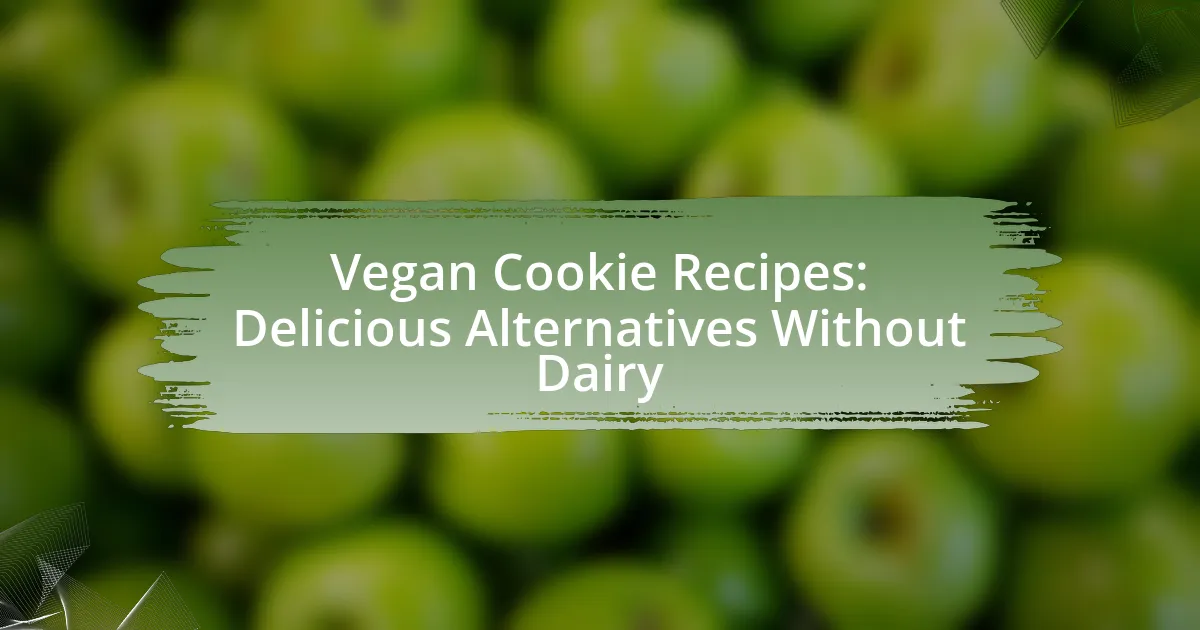Gluten-free cookies are baked goods made without gluten, utilizing alternative flours such as almond, coconut, or gluten-free all-purpose flour. This article explores the differences between gluten-free and traditional cookies, common ingredients used in gluten-free recipes, and the challenges of gluten-free baking. It also highlights the benefits of gluten-free cookies for individuals with dietary restrictions, offers tips for successful baking, and discusses troubleshooting techniques to improve texture and flavor. Key practices for consistent results and proper storage methods to maintain freshness are also covered, providing a comprehensive guide for those interested in gluten-free baking.

What are Gluten-Free Cookies?
Gluten-free cookies are baked goods made without gluten, a protein found in wheat, barley, and rye. These cookies utilize alternative flours, such as almond flour, coconut flour, or gluten-free all-purpose flour, to achieve a similar texture and taste to traditional cookies. The demand for gluten-free options has increased due to dietary restrictions, such as celiac disease, which affects approximately 1% of the global population, necessitating the avoidance of gluten-containing foods.
How do gluten-free cookies differ from traditional cookies?
Gluten-free cookies differ from traditional cookies primarily in their use of alternative flours that do not contain gluten, such as almond flour, coconut flour, or rice flour. Traditional cookies typically rely on wheat flour, which contains gluten, a protein that provides structure and elasticity. In gluten-free cookies, the absence of gluten can lead to a different texture, often resulting in a denser or crumblier product. Additionally, gluten-free recipes may require binding agents like xanthan gum or eggs to mimic the properties of gluten, ensuring the cookies hold together properly.
What ingredients are commonly used in gluten-free cookie recipes?
Common ingredients used in gluten-free cookie recipes include gluten-free flours, such as almond flour, coconut flour, or rice flour, along with binding agents like xanthan gum or guar gum. These ingredients replace traditional wheat flour, allowing for a similar texture and consistency in cookies. Additionally, recipes often incorporate sugars, such as brown sugar or coconut sugar, eggs for moisture and binding, and various flavorings like vanilla extract or chocolate chips. The use of these specific ingredients ensures that the cookies maintain a desirable taste and texture while being free from gluten.
Why is gluten-free baking considered challenging?
Gluten-free baking is considered challenging because gluten, a protein found in wheat and other grains, provides structure and elasticity to baked goods. Without gluten, baked items often lack the desired texture, leading to issues such as crumbliness or density. Additionally, gluten-free flours behave differently than traditional flours, requiring specific combinations and adjustments in recipes to achieve similar results. For instance, a study published in the Journal of Food Science highlights that gluten-free baked products often need binding agents like xanthan gum or psyllium husk to mimic gluten’s properties, further complicating the baking process.
What are the benefits of baking gluten-free cookies?
Baking gluten-free cookies offers several benefits, primarily catering to individuals with celiac disease or gluten sensitivity, allowing them to enjoy treats without adverse health effects. Additionally, gluten-free cookies can be made with a variety of alternative flours, such as almond or coconut flour, which can enhance nutritional profiles by increasing protein and healthy fat content. Research indicates that gluten-free diets can lead to improved digestive health and reduced inflammation for those with gluten-related disorders. Furthermore, baking gluten-free cookies can encourage creativity in the kitchen, as bakers experiment with different ingredients and flavors to achieve desired textures and tastes.
How do gluten-free cookies cater to dietary restrictions?
Gluten-free cookies cater to dietary restrictions by using alternative flours and ingredients that do not contain gluten, making them suitable for individuals with celiac disease or gluten sensitivity. These cookies often incorporate ingredients like almond flour, coconut flour, or oat flour, which provide a safe option for those who must avoid gluten. Research indicates that approximately 1% of the population has celiac disease, necessitating gluten-free options to prevent adverse health effects. Additionally, gluten-free cookies can be made without common allergens, further accommodating various dietary needs.
What health benefits can gluten-free cookies provide?
Gluten-free cookies can provide several health benefits, particularly for individuals with celiac disease or gluten sensitivity. These cookies eliminate gluten, a protein found in wheat, barley, and rye, which can trigger adverse reactions in sensitive individuals. Additionally, gluten-free cookies often incorporate alternative flours, such as almond or coconut flour, which can be higher in protein and healthy fats compared to traditional wheat flour. This can lead to improved satiety and better blood sugar control. Furthermore, gluten-free cookies may contain more fiber if made with whole food ingredients, contributing to digestive health.

What tips can enhance gluten-free cookie baking?
To enhance gluten-free cookie baking, use a combination of gluten-free flours and starches for better texture and flavor. Blending flours like almond flour, coconut flour, and tapioca starch can create a more balanced structure, as each type contributes unique properties. For instance, almond flour adds moisture and richness, while tapioca starch provides chewiness. Additionally, incorporating xanthan gum or guar gum can mimic the elasticity of gluten, improving the overall consistency of the cookies. Research indicates that these ingredients can significantly impact the final product, making gluten-free cookies more enjoyable and satisfying.
How can ingredient substitutions improve gluten-free cookies?
Ingredient substitutions can significantly enhance the texture and flavor of gluten-free cookies. By replacing traditional gluten-containing ingredients with alternatives like almond flour, coconut flour, or oat flour, bakers can achieve a more desirable crumb and moisture level. For instance, almond flour adds richness and moisture, while coconut flour can help absorb excess liquid, creating a balanced dough. Research indicates that using a blend of gluten-free flours can mimic the properties of wheat flour, leading to improved structure and taste in baked goods. This approach allows for customization based on dietary needs and preferences, ultimately resulting in a more enjoyable cookie experience.
What are the best gluten-free flours to use?
The best gluten-free flours to use include almond flour, coconut flour, and brown rice flour. Almond flour is high in protein and healthy fats, making it a popular choice for gluten-free baking. Coconut flour is highly absorbent and adds a subtle sweetness, ideal for cookies. Brown rice flour provides a neutral flavor and good texture, often used in combination with other gluten-free flours to enhance the overall structure of baked goods. These flours are widely recognized in gluten-free baking communities for their effectiveness in creating desirable textures and flavors in cookies.
How do different sweeteners affect gluten-free cookie texture?
Different sweeteners significantly influence the texture of gluten-free cookies. For instance, granulated sugar tends to create a crispier texture due to its ability to dissolve and caramelize during baking, while brown sugar, which contains molasses, adds moisture and results in a chewier cookie. Honey and agave syrup can also contribute to a softer texture because they add liquid, which can lead to a denser cookie. Research indicates that the moisture content and chemical properties of sweeteners directly affect the final product’s structure, as seen in studies comparing the effects of various sweeteners on baked goods.
What techniques can ensure successful gluten-free cookie baking?
To ensure successful gluten-free cookie baking, use a combination of appropriate gluten-free flours, proper hydration, and the right binding agents. Gluten-free flours such as almond flour, coconut flour, or a gluten-free all-purpose blend provide the necessary structure and flavor. Proper hydration is crucial; gluten-free doughs often require more liquid than traditional doughs to achieve the right consistency. Additionally, incorporating binding agents like xanthan gum or psyllium husk helps mimic the elasticity that gluten provides, resulting in a better texture. These techniques are supported by baking science, which shows that the right flour and moisture balance significantly impact the final product’s quality.
How does mixing time impact gluten-free cookie dough?
Mixing time significantly impacts gluten-free cookie dough by influencing the texture and consistency of the final product. Shorter mixing times typically result in a more tender and crumbly cookie, as the ingredients remain less integrated, which is desirable for many gluten-free recipes. Conversely, longer mixing times can lead to a denser and tougher texture, as the ingredients become overly combined, which may not yield the intended lightness in gluten-free cookies. This is particularly important because gluten-free flours, such as almond or coconut flour, behave differently than wheat flour, and excessive mixing can disrupt the delicate balance needed for optimal texture.
What baking temperatures are ideal for gluten-free cookies?
The ideal baking temperature for gluten-free cookies is typically between 350°F to 375°F (175°C to 190°C). This temperature range allows for even baking and helps achieve a desirable texture, ensuring that the cookies are cooked through without becoming overly dry. Research indicates that gluten-free flours, such as almond or coconut flour, often require slightly different baking conditions compared to traditional wheat flour, making this temperature range effective for optimal results.

What common mistakes should be avoided when baking gluten-free cookies?
When baking gluten-free cookies, common mistakes to avoid include not using a proper gluten-free flour blend, which can lead to poor texture and taste. Gluten-free flours vary in absorbency and protein content, so using a blend specifically designed for baking ensures better results. Another mistake is not measuring ingredients accurately; gluten-free baking often requires precise measurements to achieve the right consistency. Additionally, overmixing the dough can result in a dense cookie, as gluten-free flours do not have the same elasticity as wheat flour. Lastly, failing to let the dough rest can affect the final product, as resting allows the flours to hydrate properly, improving texture and flavor.
How can overmixing affect gluten-free cookies?
Overmixing can lead to dense and tough gluten-free cookies. This occurs because gluten-free flours, such as almond or coconut flour, do not have the same elasticity as wheat flour, and excessive mixing can break down the structure of the dough, resulting in a less desirable texture. Studies indicate that gluten-free baked goods benefit from minimal mixing to maintain a light and tender crumb, as overmixing disrupts the balance of moisture and fat, leading to a dry and crumbly product.
What signs indicate that gluten-free cookies are overbaked?
Signs that indicate gluten-free cookies are overbaked include a darkened color, a hard texture, and excessive dryness. When gluten-free cookies are overbaked, they often turn a darker shade than intended, indicating that they have been exposed to heat for too long. Additionally, the texture becomes hard rather than soft and chewy, which is characteristic of properly baked cookies. Excessive dryness is another clear sign, as overbaked cookies lose moisture, resulting in a crumbly and unpalatable product. These indicators are essential for achieving the desired quality in gluten-free baking.
Why is it important to measure ingredients accurately?
Measuring ingredients accurately is crucial for achieving the desired texture and flavor in gluten-free cookies. Gluten-free baking relies on precise ratios of ingredients because the absence of gluten makes the dough less forgiving than traditional recipes. For instance, using too much flour can lead to dry, crumbly cookies, while too little can result in a flat, unstructured product. Studies show that accurate measurements can improve consistency and quality in baking, as variations can significantly affect the chemical reactions during the baking process. Therefore, precise measurement ensures that the cookies rise properly and maintain the intended taste and texture.
What troubleshooting tips can help with gluten-free cookie baking?
To troubleshoot gluten-free cookie baking, ensure you use a proper gluten-free flour blend that includes xanthan gum or a similar binding agent to mimic the elasticity of gluten. Adjusting the moisture content is also crucial; gluten-free flours often require additional liquid or fat to achieve the right texture. If cookies spread too much, consider chilling the dough before baking, as this can help maintain their shape. For cookies that are too dry or crumbly, adding an extra egg or a bit of applesauce can improve moisture and binding. These tips are supported by baking experts who emphasize the importance of ingredient ratios and adjustments specific to gluten-free baking.
How can you fix dry or crumbly gluten-free cookies?
To fix dry or crumbly gluten-free cookies, add moisture by incorporating ingredients such as additional eggs, applesauce, or yogurt. These ingredients help bind the dough and enhance moisture content, which is crucial since gluten-free flours often lack the elasticity and moisture retention of traditional wheat flour. For instance, adding one extra egg can significantly improve the texture, as eggs provide both moisture and structure. Additionally, consider reducing the amount of dry ingredients or increasing the fat content, such as butter or oil, to achieve a softer consistency.
What should you do if gluten-free cookies spread too much?
If gluten-free cookies spread too much, you should chill the dough before baking. Chilling the dough solidifies the fats, which helps maintain the cookie shape during baking. Additionally, you can increase the amount of gluten-free flour or add a binding agent like xanthan gum to improve structure and reduce spreading. These adjustments are supported by baking science, which indicates that temperature and ingredient ratios significantly affect cookie texture and spread.
What are some best practices for baking gluten-free cookies?
To bake gluten-free cookies successfully, use a combination of gluten-free flours, such as almond flour or coconut flour, to achieve the desired texture. These flours provide different properties; for instance, almond flour adds moisture and richness, while coconut flour absorbs liquid, requiring adjustments in the recipe. Additionally, incorporating binders like xanthan gum or psyllium husk helps mimic the elasticity of gluten, ensuring the cookies hold together.
It is also essential to measure ingredients accurately, as gluten-free baking is sensitive to ratios. Using a kitchen scale can enhance precision. Furthermore, allowing the dough to rest for at least 30 minutes can improve the texture by giving the flours time to hydrate. Lastly, baking at a slightly lower temperature can prevent over-browning, which is common with gluten-free cookies. These practices are supported by baking experts who emphasize the importance of ingredient selection and measurement in gluten-free baking.
How can you ensure consistent results with gluten-free cookies?
To ensure consistent results with gluten-free cookies, use a reliable gluten-free flour blend that mimics the properties of wheat flour. This is crucial because gluten-free flours vary significantly in texture and moisture absorption. For example, a blend containing rice flour, tapioca starch, and potato starch often yields better results due to its balanced composition. Additionally, measuring ingredients accurately with a kitchen scale can prevent variations in dough consistency, which is essential for achieving uniform baking outcomes. Consistency in baking temperature and time is also vital; using an oven thermometer can help maintain the correct temperature, ensuring even baking.
What storage tips help maintain the freshness of gluten-free cookies?
To maintain the freshness of gluten-free cookies, store them in an airtight container at room temperature. This method prevents moisture loss and keeps the cookies soft. Additionally, placing a slice of bread in the container can help retain moisture, as the bread will absorb excess air moisture, keeping the cookies from becoming stale. Research indicates that gluten-free baked goods tend to dry out faster than their gluten-containing counterparts, making proper storage essential for maintaining texture and flavor.




